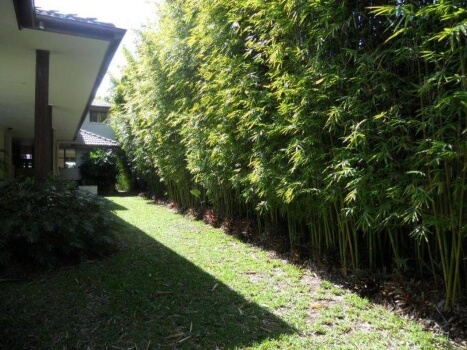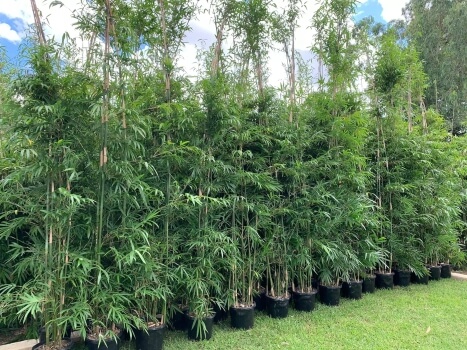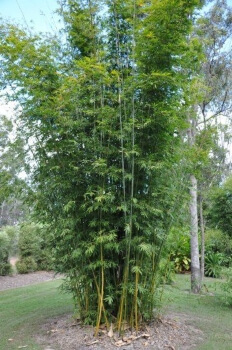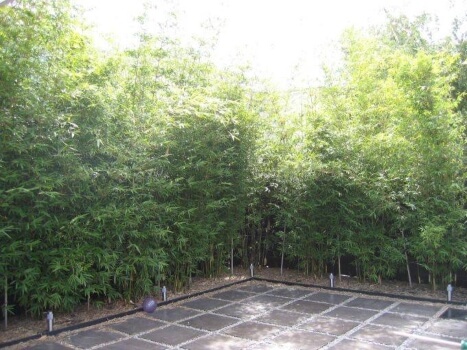Gracilis is Latin for thin, slender, and graceful. I couldn’t think of a better way to describe the Gracilis bamboo. They are neat and lush, and add a sense of serenity wherever they are planted. In our how to grow and care guide, we’ll officially introduce you to the Gracilis bamboo.
We’ll talk you through how to propagate your own plant, how to care for your bamboo in terms of light, water and food, and what pests and diseases to look out for. There are some frequently asked questions that we chat through too.
More...

Source: Red Cloud Bamboo
Family: | Poaceae |
|---|---|
Genus: | Bambusa |
Species: | B. textilis var. gracilis |
Common Names: | Gracilis bamboo, Slender Weavers Bamboo |
Location: | Indoor or outdoor |
Type: | Evergreen grass |
Growth: | Up to 8 metres tall and 1 metre wide |
Sun requirements: | Full sun to part shade |
Foliage Colour: | Green |
Flower Colour: | None |
Flowering: | None |
Fruit: | None |
Maintenance level: | Low |
Poisonous for pets: | No |
Introducing Gracilis Bamboo

Source: True Green Nursery
This kind of bamboo is incredibly popular in Australia and without a doubt, a best seller. What makes it so loved, is that it makes the perfect privacy screen that can grow to a few metres in height. It’s super easy to prune as well.
The Gracilis bamboo grows upwards naturally. This is different to other bamboo plants that tend to grow outwards. Although it’s more upright, it still has a lush bushy green leaf structure.
In nature, this bamboo likes to spread out around 1 metre in width, but it’s perfectly suited to plant in more narrow areas if you need to and you can just maintain its size as needed.
Slender Weavers Bamboo Features
Gracilis bamboo grows incredibly quickly – within 2 years it can achieve full grown size. You’ll love how low maintenance this plant is, and the fact that once established, the bamboo is drought tolerant and handles frost like a pro.
This is considered as a clumping bamboo as it grows in a circular pattern but it is also not invasive. Gracilis bamboo will do well in a pot or planted in the garden, as long as it has free draining soil. Enjoy the edible leaves for cooking too!
If you’re looking for garden screening inspiration, have a look at our best garden screening ideas of 2023. Screening can be more than just functional – it can be beautiful too!Growing Gracilis Bamboo in Australia

Source: The Bamboo Jungle
How to Propagate Gracilis bamboo
The best way to propagate your own Gracilis bamboo is from a cutting. Try and do this during the warmer seasons as this will help the bamboo as it grows. They like lots of humidity and a nice warm temperature.
Aim to take a cutting from a mature stem that is at least a year old. You’ll need to ensure the diameter is at least 7mm. This is important so the stem will be able to hold onto enough water for the new cutting as it grows.
The cutting should be taken about 10 cm above and below the node of the Gracilis bamboo stem. There should be a main branch protruding from the node.
You can take all the little branches and leaves off the node but just leave the main branch. Plant the cutting in a big pot with some potting mix and you can use root hormone on the tip to help it along.


Get Your Free Guide:
Master Growing Australian Natives eBook
A Must Have Complete Guide for Every Australian Garden
Get Your Free Guide:
Master Growing Australian Natives eBook
A Must Have Complete Guide for Every Australian Garden
Check out our review of the best rooting hormones available online in Australia.
When you actually plant the cutting, it should be at a slight angle from being fully parallel to the ground. As a guideline, the main branch should be sticking up out of the soil, and the bud part should be under the soil.
Your pot with the cutting can be placed somewhere shady and our recommendation is to water it every day for about 4 weeks.
Bamboo Gracilis Care Guide

Source: Sydney Plant Market
Sunlight Needs
Your Gracilis bamboo can grow in any light from full sun to part shade.
Best Soil to Use
Gracilis bamboo can grow in a whole range of soil types, but a rich and well-draining choice will see it grow vibrantly. A good quality organic soil mix would be great and mulch well with an organic mulch.
Watering Bambusa textilis var. gracilis
Gracilis bamboo needs a decent amount of water while the plant is establishing itself and then becomes drought tolerant. Watering during the hotter months will still help your bamboo live to its full potential.
Gracilis Bamboo Fertiliser
Giving your bamboo a liquid fertiliser every 2 to 3 weeks will help its root development in the early growing days. Eventually you can use a slow release fertiliser every 3 months. Make sure it's high in nitrogen to keep those leaves gorgeous green and to help the bamboo with new growth.
Pruning Slender Weavers
Gracilis bamboo handles pruning well. You can do a good trim once a year and then as needed to maintain its height and spread.
Common Gracilis Bamboo Pests and Diseases
Aphids
Aphids are a common pest that likes to feed on bamboo and there are actually different species of aphid that might affect your plant. These pests operate by sucking sap from your bamboo.
This causes damage to the plant but can also encourage diseases. If you’ve ever dealt with an aphid infestation, you know that they grow in numbers quickly. It’s hard to believe that such a tiny pest with a soft body can be such a nuisance.
You’ll notice that the leaves of your Gracilis bamboo will start to wilt. Growth of your plant will also be stunted. The aphids leave behind a sticky honeydew which can cause even more problems like sooty mould.
If you’re trying to see the tiny pests on your plant you might need a magnifying glass because they really are tiny. Aphids can be green, brown, red, yellow or black. A product like neem oil is environmentally friendly and effective in smothering these critters.
For more info about how to identify and get rid of aphids, have a look at our article here. They are the most common garden pest in the world, so any expertise you can gain about this critter can only benefit you and your garden.
Bamboo Mealybug
Much like aphids, mealybugs also suck sap from the bamboo plant and leave behind their sticky residue. You might notice that the leaves and stem of your Gracilis bamboo start to look worse for wear, with strange colouring.
If you notice a white fluff on your plant, this is usually evidence that you’re dealing with mealybug. The bug itself is really small and a pink colour.
You can remove the bugs from your plant using rubbing alcohol on a cotton bud and then follow up with a treatment like neem oil to keep any infestations at bay.
Scale
This is another tiny pest that has a waxy shell. The younger ones are a light colour and this gets darker as they get older (making them easier to see).
They suck the sap of your Gracilis bamboo plant, which affects the bamboo’s ability to get the nutrients that it needs. The scale pests like to congregate together and you might not even notice them until you’re dealing with a serious infestation.
You might notice some brown grey patches on your Gracilis bamboo. The scale will secrete honeydew on the bamboo and this of course attracts other pests and can cause sooty mould.
Spray your Gracilis bamboo with neem oil to smother and get rid of a scale infestation.
Root Rot
This is a fungal disease caused by soil that is soggy and can’t drain properly. The leaves will start to discolour and fall off and the plant can die off entirely if there is no treatment.
If your bamboo starts to crumble or look spongy, you’re probably dealing with root rot. You might also notice some mushrooms growing around the base of the Gracilis bamboo.
Treatment involves changing the soil if your bamboo is potted, pruning and cutting off affected leaves and any rotting roots, and safely discarding infected parts of the plant.
Black sooty mould
This is usually characterised by black spots that look like ash and is often secondary to the work of pests we’ve already chatted about like aphids and scale. Black sooty mould is in fact quite a common thing that Gracilis bamboo has to deal with.
You’re now likely dealing with an insect infestation and a mould that has escalated. The sooty mould won’t actually kill the plant but any unmanaged pests could eventually kill off your bamboo if the infestation and secondary effects are severe enough.
You can get rid of the mould by washing it off the leaves with a soapy water mix that is very mild. You can leave the solution on the plant for a few minutes and then rinse it off.
Gracilis Bamboo Frequently Asked Questions

Source: Red Cloud Bamboo
What does it mean if my Gracilis bamboo has leaves that are turning yellow or brown?
If you’re sure that you’re not dealing with any pest or disease, this could mean that your plant just needs some tender loving care. Perhaps the soil needs to be better, the plant needs nutrients, or your watering schedule is insufficient.
Just an important note that yellow leaves are also normal during the spring time as the life cycle of the plant moves on.
Can you actually eat the shoots of a bamboo plant, and if so, can you eat the Gracilis bamboo?
The shoots of a bamboo plant actually release hydrogen cyanide when you chew them. Depending on how much of this chemical is present, this would determine the taste and whether it is even edible, or just too bitter to get down.
In nature this is handy to keep animals from feasting on fresh growth. When you boil the bamboo leaves, the toxic chemicals get broken down and then they can be eaten.
Most types of bamboo need to be prepared like this before you can eat it. Here are some tips on how to eat bamboo.
Some types of bamboo are less bitter and easier to eat, even raw. The larger species are often the ones that are edible. Going back to the Gracilis bamboo, the fresh new shoots can indeed be eaten as is if you wish, or you could prepare them as you traditionally would with other bamboo.
Does the Gracilis bamboo have any interesting uses?
The stems of the bamboo can be cut lengthways and have incredible strength. They are used to weave baskets, and make furniture and musical instruments.
Needing inspiration to get started with your garden, or looking for advice on a particular garden category? Sign up for our newsletter here.
Wrappin Up Our Gracilis Bamboo Growing and Care Guide
Gracilis bamboo is lush and green the whole year round, making it a great choice for any garden. If planted next to a water feature or pool, you won’t have to worry about constant messy leaf drop either.
It adds privacy, beauty, and a sense of luxury to any garden which is why we are giving the Gracilis bamboo a thumbs up.
Published on November 8, 2022 by Maisie Blevins
Last Updated on October 18, 2024





Dear Maisie Blevins,
We planted 6 – 20 gal. pots of slender weaver's bamboo. We cut the large pots in half and made 12 plantings. We spaced them 6 feet apart. What is the rate of watering needed. How often and how much. We are currently watering 3 times a day at 30-minute intervals which gives the plant 4.5 gal. 3 time a day. Is this enough or not enough. I'm a little nervous because it was expensive. We spent close to 3K if you include the peat moss and bags of compost not counting 2-1/2 days of labor. I would greatly appreciate any wisdom you could share.
Thank you,
Greg F. from Florida
Hi there Greg,
Thanks for your question.
I totally understand that you want to make sure you’re looking after your slender weavers correctly, especially after such an investment. While I can offer some advice, it’s hard for me to say exactly how much water your particular plants need as this can be affected by many factors including the weather, soil and humidity among others.
Based on my understanding of your plantings, I would say that 4.5 gallons three times per day may be a little excessive, even considering your current temperature ranges in Florida. Overwatering this species can cause unwanted issues like sooty mould or even root rot.
When first planted, slender weaver bamboo does need water daily and even twice daily in very warm and dry conditions. On average, plants over five gallons need about 2 to 3 gallons of water every three to four days. This is a healthy benchmark to start at and access their progress from there.
I would recommend providing your bamboo with slightly less water, perhaps reducing the watering to around 2.5 to 3 gallons twice a day and seeing how they respond. Overall, the soil shouldn’t be allowed to fully dry out and should remain slightly moist at all times, especially during initial establishment.
To gauge your plants, overwatering would lead to yellowing foliage whereas underwatering would lead to curled-up leaves and a droopy appearance overall.
I hope this information proves helpful for you and I wish you the very best with your slender weavers.
Happy gardening Greg!
Maisie Blevins